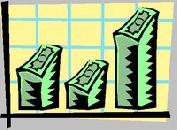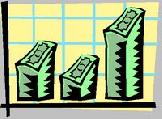
 |
|
| Financial Terms | |
| Great Depression |
|
Information about financial, finance, business, accounting, payroll, inventory, investment, money, inventory control, stock trading, financial advisor, tax advisor, credit.
Main Page: inventory control, investment, finance, credit, accounting, tax advisor, financial advisor, inventory, |
Definition of Great Depression
Great DepressionThe period of very high unemployment during the early 1930s.
Related Terms:DepressionA prolonged period of very low economic activity with large-scale unemployment. economic components modelAbrams’ model for calculating DLOM based on the interaction of discounts from four economic components. NPV (net present value of cash flows)Same as PV, but usually includes a subtraction for an initial cash outlay. PPF (periodic perpetuity factor)a generalization formula invented by Abrams that is the present value of regular but noncontiguous cash flows that have constant growth to perpetuity. PV (present value of cash flows)the value in today’s dollars of cash flows that occur in different time periods. Accelerated cost recovery system (ACRS)Schedule of depreciation rates allowed for tax purposes. Annualized holding period returnThe annual rate of return that when compounded t times, would have  Asset activity ratiosRatios that measure how effectively the firm is managing its assets. Average collection period, or days' receivablesThe ratio of accounts receivables to sales, or the total Blow-off topA steep and rapid increase in price followed by a steep and rapid drop. This is an indicator seen Cash deliveryThe provision of some futures contracts that requires not delivery of underlying assets but Cash flowIn investments, it represents earnings before depreciation , amortization and non-cash charges. Cash flow after interest and taxesNet income plus depreciation. Cash flow coverage ratioThe number of times that financial obligations (for interest, principal payments, Cash flow from operationsA firm's net cash inflow resulting directly from its regular operations Cash flow matchingAlso called dedicating a portfolio, this is an alternative to multiperiod immunization in  Cash flow per common shareCash flow from operations minus preferred stock dividends, divided by the Cash flow time-lineLine depicting the operating activities and cash flows for a firm over a particular period. Cash-flow break-even pointThe point below which the firm will need either to obtain additional financing Compounding periodThe length of the time period (for example, a quarter in the case of quarterly Credit periodThe length of time for which the customer is granted credit. DeliveryThe tender and receipt of an actual commodity or financial instrument in settlement of a futures contract. Delivery noticeThe written notice given by the seller of his intention to make delivery against an open, short Delivery optionsThe options available to the seller of an interest rate futures contract, including the quality Delivery pointsThose points designated by futures exchanges at which the financial instrument or Delivery priceThe price fixed by the Clearing house at which deliveries on futures are in invoiced; also the Delivery versus paymentA transaction in which the buyer's payment for securities is due at the time of  Discount periodThe period during which a customer can deduct the discount from the net amount of the bill Discounted cash flow (DCF)Future cash flows multiplied by discount factors to obtain present values. Discounted payback period ruleAn investment decision rule in which the cash flows are discounted at an Discretionary cash flowCash flow that is available after the funding of all positive NPV capital investment Economic assumptionseconomic environment in which the firm expects to reside over the life of the Economic defeasanceSee: in-substance defeasance. Economic dependenceExists when the costs and/or revenues of one project depend on those of another. Economic earningsThe real flow of cash that a firm could pay out forever in the absence of any change in Economic exposureThe extent to which the value of the firm will change because of an exchange rate change. Economic incomeCash flow plus change in present value. Economic order quantity (EOQ)The order quantity that minimizes total inventory costs. Economic rentsProfits in excess of the competitive level. Economic riskIn project financing, the risk that the project's output will not be salable at a price that will Economic surplusFor any entity, the difference between the market value of all its assets and the market Economic unionAn agreement between two or more countries that allows the free movement of capital, Economies of scaleThe decrease in the marginal cost of production as a plant's scale of operations increases. Equivalent annual cash flowAnnuity with the same net present value as the company's proposed investment. Evaluation periodThe time interval over which a money manager's performance is evaluated. Expected future cash flowsProjected future cash flows associated with an asset of decision. Flower bondGovernment bonds that are acceptable at par in payment of federal estate taxes when owned by Flow-through basisAn account for the investment credit to show all income statement benefits of the credit Flow-through methodThe practice of reporting to shareholders using straight-line depreciation and Forward deliveryA transaction in which the settlement will occur on a specified date in the future at a price Free cash flowsCash not required for operations or for reinvestment. Often defined as earnings before Good deliveryA delivery in which everything - endorsement, any necessary attached legal papers, etc. - is in Good delivery and settlement proceduresRefers to PSA Uniform Practices such as cutoff times on delivery Hell-or-high-water contractA contract that obligates a purchaser of a project's output to make cash High-coupon bond refundingRefunding of a high-coupon bond with a new, lower coupon bond. High priceThe highest (intraday) price of a stock over the past 52 weeks, adjusted for any stock splits. High-yield bondSee:junk bond. Highly leveraged transaction (HLT)Bank loan to a highly leveraged firm. Holding periodLength of time that an individual holds a security. Holding period returnThe rate of return over a given period. Incremental cash flowsDifference between the firm's cash flows with and without a project. Law of large numbersThe mean of a random sample approaches the mean (expected value) of the Leading economic indicatorseconomic series that tend to rise or fall in advance of the rest of the economy. Low-coupon bond refundingRefunding of a low coupon bond with a new, higher coupon bond. Low priceThis is the day's lowest price of a security that has changed hands between a buyer and a seller. Low price-earnings ratio effectThe tendency of portfolios of stocks with a low price-earnings ratio to Making deliveryRefers to the seller's actually turning over to the buyer the asset agreed upon in a forward contract. Multiperiod immunizationA portfolio strategy in which a portfolio is created that will be capable of Net periodThe period of time between the end of the discount period and the date payment is due. Neutral periodIn the Euromarket, a period over which Eurodollars are sold is said to be neutral if it does not Nominal cash flowA cash flow expressed in nominal terms if the actual dollars to be received or paid out are given. Operating cash flowEarnings before depreciation minus taxes. It measures the cash generated from Overnight delivery riskA risk brought about because differences in time zones between settlement centers Plowback rateRelated: retention rate. Price discovery processThe process of determining the prices of the assets in the marketplace through the Price-specie-flow mechanismAdjustment mechanism under the classical gold standard whereby Production-flow commitmentAn agreement by the loan purchaser to allow the monthly loan quota to be Rally (recovery)An upward movement of prices. Opposite of reaction. Real cash flowA cash flow is expressed in real terms if the current, or date 0, purchasing power of the cash ScaleA bank that offers to pay different rates of interest on CDs of varying rates is said to "post a scale." Scale enhancingDescribes a project that is in the same risk class as the whole firm. Scale inWhen a trader or investor gradually takes a position in a security or market over time. Scheduled cash flowsThe mortgage principal and interest payments due to be paid under the terms of the Statement of cash flowsA financial statement showing a firm's cash receipts and cash payments during a Statement-of-cash-flows methodA method of cash budgeting that is organized along the lines of the statement of cash flows. Subperiod returnThe return of a portfolio over a shorter period of time than the evaluation period. T-period holding-period returnThe percentage return over the T-year period an investment lasts. Taking deliveryRefers to the buyer's actually assuming possession from the seller of the asset agreed upon Unemployment rateThe ratio of the number of people classified as unemployed to the total labor force. Waiting periodTime during which the SEC studies a firm's registration statement. during this time the firm WallflowerStock that has fallen out of favor with investors; tends to have a low P/E (price to earnings ratio). Workout periodRealignment period of a temporary misaligned yield relationship that sometimes occurs in CASH-FLOW STATEMENTA statement that shows where a company’s cash came from and where it went for a period of time, such as a year. CASH FLOWS FROM FINANCING ACTIVITIESA section on the cash-flow statement that shows how much cash a company raised by selling stocks or bonds this year and how much was paid out for cash dividends and other finance-related obligations. CASH FLOWS FROM INVESTING ACTIVITIESA section on the cashflow statement that shows how much cash came in and went out because of various investing activities like purchasing machinery. CASH FLOWS FROM OPERATIONSA section on the cash-flow Stockholders’ equity statement that shows how much cash came into a company and how much went out during the normal course of business. MACRS (Modified Accelerated Cost Recovery System)A depreciation method created by the IRS under the Tax Reform Act of 1986. Companies must use it to depreciate all plant and equipment assets installed after December 31, 1986 (for tax purposes). Accounting periodThe period of time for which financial statements are produced – see also financial year. Activity-based budgetingA method of budgeting that develops budgets based on expected activities and cost drivers – see also activity-based costing. Activity-based costingA method of costing that uses cost pools to accumulate the cost of significant business activities and then assigns the costs from the cost pools to products or services based on cost drivers. Allocation base A measure of activity or volume such as labourhours, machine hours or volume of production Related to : financial, finance, business, accounting, payroll, inventory, investment, money, inventory control, stock trading, financial advisor, tax advisor, credit. |